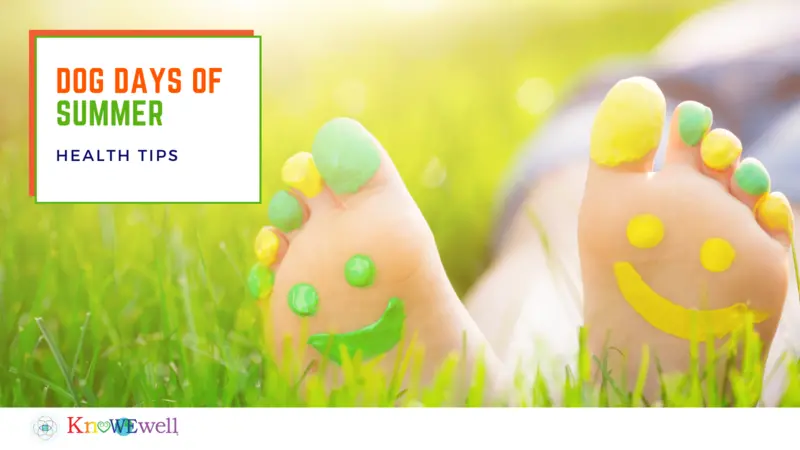

WELLthier Living and Aging

WELLthier Living and Aging
Health Tips for the Dog Days of Summer
Summer is a time for fun, relaxation, and making memories. Staying healthy will help you enjoy this special season.
Summer is a time to treasure: warm nights by the campfire roasting marshmallows, lazy beach days with a cool breeze off salty water, and family fun days at the pool. Summer is for good health and happy times. More physical activity helps reduce stress and daylight enhances good mood. From food to sun to play, the summer is a time to enjoy.
Fresh fruits in summer are bountiful. Loaded with antioxidants, berries are a popular summer fruit that help maintain good health by keeping free radicals under control in the body. These are unstable molecules that can damage cells when their numbers get too high, causing oxidative stress. Natural foods like berries can help eliminate free radicals from the body and contain antioxidants, such as anthocyanins, ellagic acid, and resveratrol. Not only do these antioxidants protect cells, but they have also been found to reduce the risk of disease.
It has been scientifically proven that blueberries, blackberries, and raspberries have the highest antioxidant activity of commonly consumed fruits. Berries may also improve blood sugar and insulin levels. In fact, a six-week study concluded that obese people with insulin resistance who drank a blueberry smoothie twice a day experienced greater improvements in insulin sensitivity than those who consumed berry-free smoothies.
Loaded with antioxidants, berries are a popular summer fruit that help maintain good health by keeping free radicals under control in the body.
Berries are a good source of soluble fiber. Studies show that consuming soluble fiber slows down the movement of food through the digestive tract. In addition to being high in antioxidants, they also contain several vitamins and minerals, are abundant in anti-inflammatory properties, and decrease the risk of heart disease. If that isn’t enough, the antioxidants in berries can reduce skin wrinkling. These antioxidants include anthocyanins, ellagic acid, and resveratrol, which are known to reduce the risk of cancer.
Another benefit of summer is an abundance of vitamin D from exposure to sunlight, which has long been known to help the body in numerous ways. When ultraviolet (UV) rays hit the skin, the liver and kidneys create the active form of vitamin D, which improves bone health, reduces inflammation, enhances the immune and nervous systems. This is more effective than eating food sources of vitamin D such as fatty fish, mushrooms, tofu, eggs, and fortified milks. Vitamin D from the sun also stimulates serotonin production in the brain. Known as the “happy hormone,” serotonin stabilizes mood, enables better sleep, and aids in digestion.
Ultraviolet radiation exposure has been used for decades by doctors to treat multiple skin diseases such as psoriasis and eczema as well as to improve bone health by lowering the risk of fractures. Exposure to sunlight has also been used to treat rheumatoid arthritis, lupus erythematosus, and inflammatory bowel disease since vitamin D has such a vital role in reducing inflammation and supporting the immune system.
The concern with too much exposure to the sun is skin cancer, which is one of the most common forms of cancer worldwide. Research from recent decades shows that the three main forms of skin cancer, melanoma, basal cell carcinoma, and squamous cell carcinoma, can be attributed to excess sun exposure. But there are some cancers that can result from too little sun exposure. Hodgkin lymphoma, breast, ovarian, colon, and pancreatic cancers are more common in the higher latitudes.
More than a million people in the US are diagnosed with skin cancer each year.
More than a million people in the US are diagnosed with skin cancer each year. Precautions can be taken to limit sun exposure such as wearing protective clothing and staying in shaded areas during the height of the day. Those with fair skin or freckles tend to have a higher chance of developing skin cancer. Finding the balance of the health benefits of the sun while being careful is the challenge.
It’s recommended to avoid direct sunlight during the hours of 10 a.m. and 4 p.m. when the sun is most potent. The World Health Organization states that 5 to 15 minutes of casual sun exposure to hands, face, and arms two to three times a week during the summer months is sufficient to keep vitamin D levels in the normal range. But to reach more optimal ranges, a longer duration, such as 15 to 30 minutes of casual sun exposure prior to application of sunscreen may be more beneficial. It’s also important to check the sunscreen’s expiration date. Sunscreen without an expiration date has a shelf life of no more than three years.
There has long been a debate about sunscreen as many have been found to cause harm. Sunscreens have chemicals that absorb or reflect both types of UV radiation (UVA and UVB). The safest forms of sunscreen, according to the Food and Drug Administration, are zinc oxide and titanium dioxide, two ingredients classified as “mineral product” sunscreens. It’s recommended to use sunscreen with an SPF (sun protection factor) of 30 or higher, which should be reapplied every two hours.
Other ingredients common in about 60% of all sunscreens—including oxybenzone, avobenzone, homosalate, octinoxate, octisalate, and octocrylene—have been found “unsafe” as they may interfere with normal functioning of a number of hormones, including estrogen. The Environmental Working Group is a third-party group that provides a guide to search sunscreen brands and check ingredients.
Experts encourage wearing long-sleeved shirts whenever possible to provide protection from UV rays. Clothes made from tightly woven fabric offer the best protection. A hat with a brim all the way around that shades the face, ears, and the back of the neck is also recommended. Sunglasses are also an essential accessory as they protect the eyes from UV rays and reduce the risk of cataracts. They also protect the tender skin around the eyes from sun exposure.
It’s also important to plan time to have fun. With the pandemic still circulating, families have had to be inventive of late and are choosing cross-country travel and road trips. The US has many beautiful places to see from Maine to Washington. From breathtaking mountains with clear, starry nights to the grandeur of the oceans, the country is rich with history and beauty. Although travel has become more challenging due to COVID-19 restrictions that can change rapidly, checking state regulations often and taking precautions is essential.
The risk of dehydration is amplified while consuming alcohol.
One thing that many have learned in the past 18 months is the importance of family time. Summer is perfect for spending time with the people who are most important in our lives. Traveling as a family makes memories that last a lifetime, and is a great way to visit distant relatives.
The Centers for Disease Control and Prevention (CDC) currently recommends wearing a mask over the nose and mouth. Masks are required on planes, trains, and buses while maintaining six-feet distance when possible. Frequent handwashing and avoiding crowds are also recommended. Renting a house or cabin, according to the CDC, is safer than staying in a hotel.
Whether enjoying a cocktail by the pool or walking on the beach, it’s important to stay hydrated. Whenever one is outside in the heat for prolonged periods of time, the risk of dehydration is great. This risk is amplified while consuming alcohol. Alcohol reduces the release of the hormone vasopressin, which keeps body fluids balanced. It is also a diuretic, which causes more urination. With these factors added to the sweat released on a hot day, there is risk of dehydration. Summer cocktails can also be potent, causing blood alcohol levels to climb quickly. Choosing to drink responsibly will make for a happy and safe time.
The joy of summer includes family time, a time to put down the electronics and have fun. Daily activities do not have to be more than hunting for tadpoles or having a picnic. It’s the little moments that make the best memories.
REFERENCES
Brady, D. and Moyer, D. (June 22, 2021). Sun exposure: The dark and bright spots. https://drdavidbrady.com/sun-exposure-the-bright-and-dark-sides/?
Centers for Disease Control and Prevention. (n.d.) Sun safety. https://www.cdc.gov/cancer/skin/basic_info/sun-safety.htm
Centers for Disease Control and Prevention. (2021, August) Safer travel tips for families with unvaccinated children. https://www.cdc.gov/coronavirus/2019-ncov/travelers/travel-risk.html
Cleveland Clinic. (2021, July 14.) The risks of mixing alcohol and summer heat. https://health.clevelandclinic.org/dangers-of-too-much-alcohol-summer-heat/?
Day, S. (2021, June 21). How to give your kids a 1980s-inspired summer. Very Well Family. https://www.verywellfamily.com/1980s-summer-kids-ideas-5186280
Healthline. (n.d.) 11 reasons why berries are among the healthiest foods on earth. https://www.healthline.com/nutrition/11-reasons-to-eat-berries
Lebowitz Ross, H. (n.d.) The ABCs of Summer: An a to z guide to the summer season. Parents. https://www.parents.com/fun/activities/outdoor/abcs-of-summer-season/
Mayo Clinic. (n.d.) COVID-19 (coronavirus) travel advice. https://www.mayoclinic.org/diseases-conditions/coronavirus/in-depth/coronavirus-safe-travel-advice/…
National Center for Complementary and Integrative Health. (n.d.) Complementary health approaches for travelers. https://www.nccih.nih.gov/health/complementary-health-approaches-for-travelers?nav=govd
National Institute on Alcohol Abuse and Alcoholism. (n.d.). Risky drinking can put a chill on your summer fun. https://www.niaaa.nih.gov/publications/brochures-and-fact-sheets/risky-drinking-can-put-chill-on-yo…
United States Department of Transportation. (n.d.) Summer driving tips 2021. https://www.nhtsa.gov/summer-driving-tips
Velarde, C. (2020, August). The 14 best road trips in the U.S. MSN. https://www.msn.com/en-us/travel/tripideas/the-14-best-road-trips-in-the-us-to-take-in-2020/


 By
By







